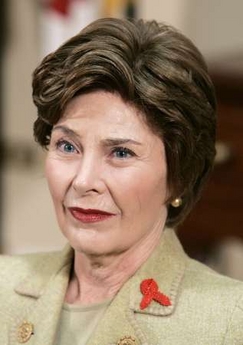Newsmaker
Laura Bush: Skin cancer 'no big deal'
(AP)
Updated: 2006-12-20 08:49
 |
Large Medium Small |
WASHINGTON - US First lady Laura Bush said Tuesday she did not disclose she had a skin cancer tumor removed five weeks ago because, "It's no big deal and we knew it was no big deal at the time."
Mrs. Bush's comments, relayed by presidential spokesman Tony Snow, came a day after the White House belatedly acknowledged she had a squamous cell carcinoma, the second most common form of skin cancer, excised from her right shin a few days after the Nov. 7 election. The troublesome patch was about the size of a nickel, her spokeswoman said.
Unlike her husband, the first lady is not an elected official, Snow said. "She's got the same right to medical privacy that you do," he told reporters at a sometimes contentious briefing. He likened her skin cancer to colds, the flu, stomach aches and other non-life threatening conditions.
"You guys are really stretching it," Snow said. Mrs. Bush's problem was revealed only after the first lady's press secretary, Susan Whitson, was asked Monday evening why Mrs. Bush was wearing a bandage on her leg at a Hanukkah ceremony.
There is a keen sensitivity about White House medical problems because of attempts to hide presidential problems. The most famous case was Woodrow Wilson's stroke that left him unable to fulfill his duties and put the country in the hands of his wife, who virtually ran the White House. Richard Nixon, John F. Kennedy and Franklin D. Roosevelt also had health problems that were not fully disclosed.
Betty Ford, after her husband left office, revealed she had a drug and alcohol addiction and checked into a rehabilitation clinic.
Mrs. Bush, 60, has a significantly increased risk of developing a second non-melanoma skin cancer within the next three to five years, said Dr. Clifford Perlis, a dermatologist at Fox Chase Cancer Center in Philadelphia.
Doctors vary on how closely to watch for that, but at Fox Chase the advice generally is to come in for skin exams every six months for two years. If no new lesions appear, they're then checked annually
Whitson said the first lady was still wearing a bandage more than five weeks after the procedure because the skin on that part of the leg is thin and "it takes a little while to heal." Asked if plastic surgery might be required, Whitson said, "No further procedures are needed at this point."
A squamous cell carcinoma is a tumor that affects the middle layer of the skin. It is more aggressive than basal cell cancer, the most common form of skin cancer. Squamous cell cancer is more likely than basal cell cancer to spread to other locations, so patients need to have lymph nodes in the region near the tumor routinely examined, according to the National Cancer Institute's Web site.
People with fair skin and prolonged sun exposure are more likely to develop squamous cell carcinoma, and it is more common in the southern latitudes of the northern hemisphere. Mrs. Bush is from Texas.
Snow said that while President Bush and Vice President Dick Cheney make medical disclosures, "Other members of the family, not being elected, do not do so, and have not done so in prior administrations, and are not likely to do so."
But there is a history of public disclosure of health problems involving the first lady.
For example, the first lady's mother-in-law, Barbara Bush, disclosed she was suffering from an overactive thyroid ailment known as Graves' disease when she lived at the White House. Nancy Reagan in 1987 revealed she had breast cancer and underwent a mastectomy.
More than 1 million cases of basal and squamous cell skin cancers are diagnosed annually, according to the American Cancer Society, which says that most but not all of these forms of skin cancer are highly curable.
Mrs. Bush was noticed wearing a bandage on her leg on Oct. 23 when she and her husband posed for pictures with King Carl XVI Gustaf of Sweden. Questioned at the time, Whitson told The Associated Press it was simply a sore.
Monday night, Whitson said Mrs. Bush had a biopsy in late October because the sore was not healing. It was determined to be a squamous cell carcinoma and was removed a few days after the election, Whitson said.
Squamous cell carcinoma shouldn't be confused with melanoma, the most dangerous form of skin cancer. Together, basal and squamous cell carcinoma are responsible for less than 0.1 percent of cancer deaths, while the American Cancer Society estimates almost 8,000 Americans will die from melanoma this year.
| 分享按钮 |

